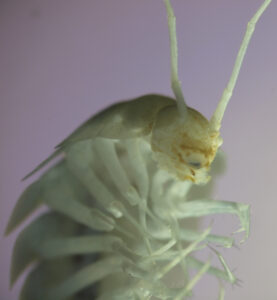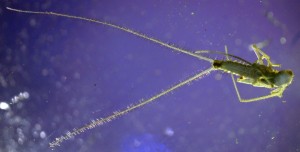Background. Cave dwelling species —in particular aquatic ones (Stygobionts) —are relatively understudied compared with terrestrial organisms. Sardinia represents a Mediterranean hotspot of endemism and species diversity, but its cave biodiversity remains woefully underexplored, especially the underwater systems (Manconi et al. 2011). Six highly complex systems are found in the south-eastern parts of the island at the Golfo di Orosei that are connected with the Mediterranean Sea. A previous study covered only the biodiversity of the first 800 m of the underwater cave Bel Torrente (Oertel & Patzner 2007).
Preliminary work. In 2012 a cave exploration was conducted in Bel Torrente, one of the larger of six cave systems of the Golfo di Orosei, exploring more than 3 km towards the island´s center, crossing two dry sump areas. This expedition organized by Thorsten Waelde and Hubert Zistler was focused on exploring new sections and to lay new lines for measuring the cave. Although the opportunity for collection of species was limited one specimen that could be collected represents probably a new undescribed isopod species for Sardinian underwater caves. So far only one stygobiont is described for Bel Torrente, the isopod Utopionicus kuehnii (Schmalfuss 2005). Additionally, in the dry passages two basal insects of the order Diplura were found, which also represent possibly previously undescribed species that are currently determined in collaboration with Nikolaus Szucsich (University of Vienna, Austria).
Project goals. The goal is to collect new terrestrial and aquatic (stygobiont) cave dwelling arthropod species focusing on two taxa in particular, with the goal of providing detailed new descriptions: a) aquatic isopod and other crustacean species in the new sections of Bel Torrente; b) basal hexapods in the dry sections. This project will be the basis for a more extensive future study comparing faunal elements of the six cave systems of the Golfo di Orosei together with other colleagues. Isopods represent perfect model organisms not only for understanding biogeographic principles for stygobiont organisms, but they also nicely illustrate Sardinia’s outstanding role as an endemism hotspot and improve understanding of global stygobiont biodiversity.
Links
http://www.scintilena.com/golfo-dorosei-bel-torrente-2013-1000-metri-di-rilievo-in-grotta-asciutta-e-500-metri-di-rilievo-nel-sifone-2/08/21/
http://www.scintilena.com/protec-sardinia-campagna-esplorativa-bel-torrente-2012/08/17/
Species pictures

One of the putative new crustacean, isopod species.

One of the putative new basal hexpods, dipluran species